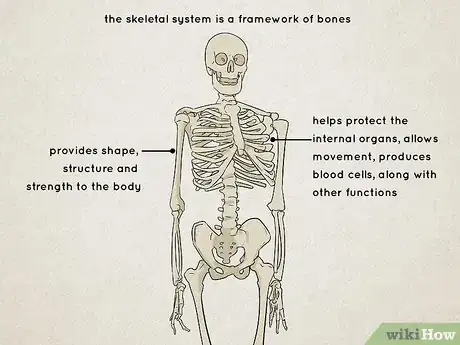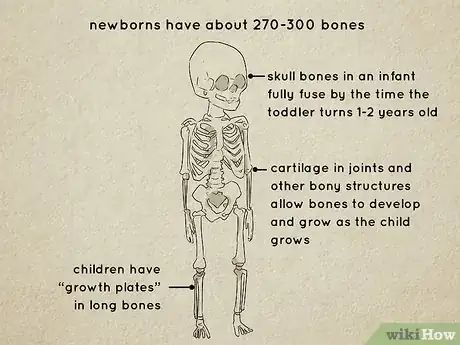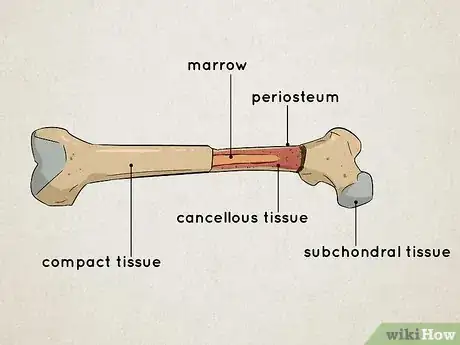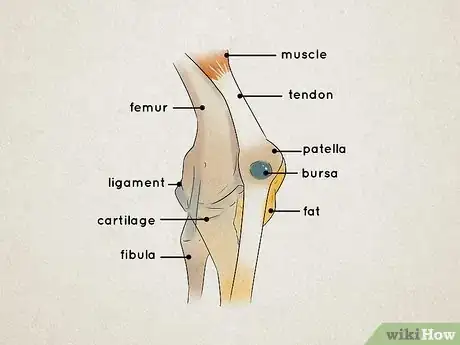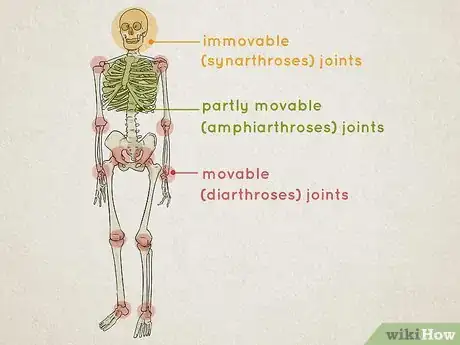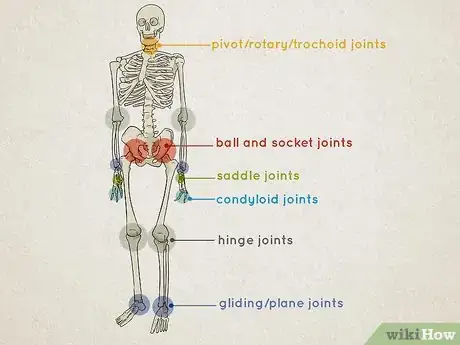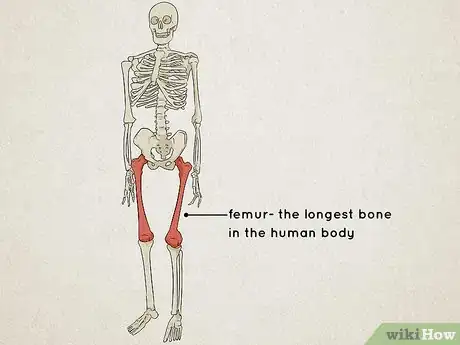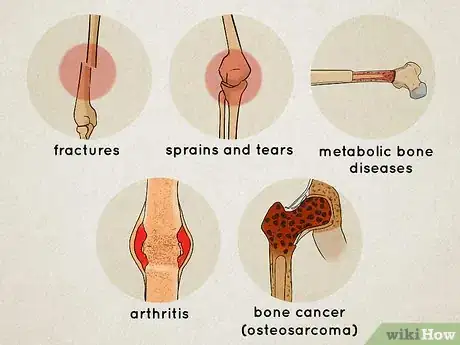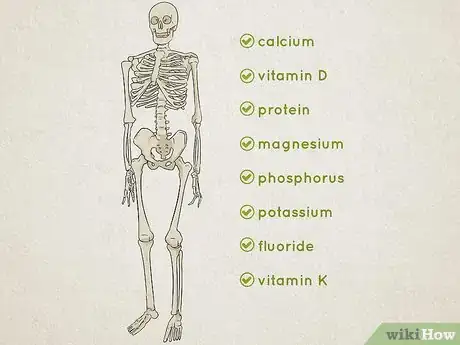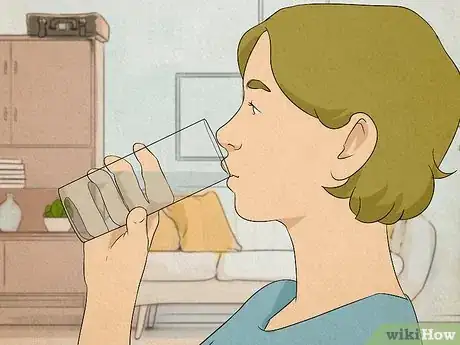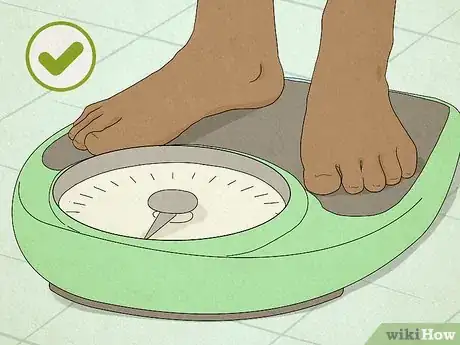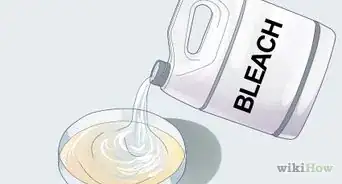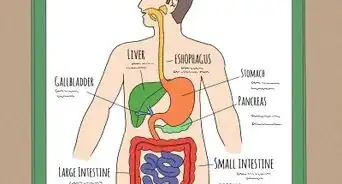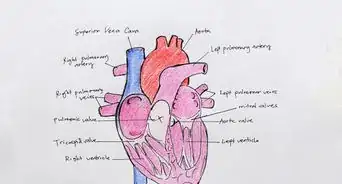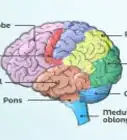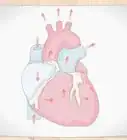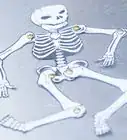This article was co-authored by Kevin Stone, MD. Dr. Kevin Stone is an orthopaedic surgeon and the founder of The Stone Clinic, a leading orthopaedic surgery, sports medicine, and rehabilitation clinic in the San Francisco Bay Area. With over 30 years of experience, Dr. Stone specializes in knee, shoulder, and ankle repair, using biologic reconstruction and joint replacement. He holds a BS in Biology from Harvard University and a Doctor of Medicine (MD) from the University of North Carolina at Chapel Hill. Dr. Stone completed his residency in Internal Medicine and Orthopaedic Surgery at Harvard University and in General Surgery at Stanford University. He then completed a fellowship in Orthopaedic Research and Surgery at the Hospital for Special Surgery and Tahoe Orthopaedics. He lectures around the world as an expert in cartilage and meniscal growth, replacement, and repair and holds over 40 U.S. patents on novel inventions to improve healthcare. Dr. Stone is a physician for Smuin Ballet and has served as a physician for the U.S. Ski Team, the U.S. Pro Ski Tour, the United States Olympic Training Center, and World Pro Ski Tour.
There are 52 references cited in this article, which can be found at the bottom of the page.
This article has been viewed 8,666 times.
There are a total of 11[1] organ systems in our bodies, and one of them is the skeletal system.[2] The skeletal system is one of the most, though not the only, important organ systems in the human body. Because of how complex an organ system can be, it can be tricky to understand! You might be trying to wrap your head around this concept for school, or just for additional knowledge. Whatever the reason, answering some questions can help! We at wikiHow will answer some commonly asked questions that'll help you better understand your skeleton.
Steps
How do I keep my skeletal system healthy?
-
1Include calcium, vitamin D, protein, magnesium, phosphorus, potassium, fluoride[77] and vitamin K[78] in your diet. As a general rule of thumb, go for a balanced diet. A balanced diet contains all nutrients in the right amount and proportion. Include fruits, vegetables, whole grains, and healthy protein! If your body gets all nutrients in the right amounts, it will keep your bones strong and healthy[79]
- Calcium helps maintain bone density and keep them strong, while Vitamin D helps your body absorb calcium.[80]
- Protein, according to several studies, have a positive impact on bone mineral density/content (BMD/BMC).[81]
- Magnesium has been shown to reduce the risk of osteoporosis.[82]
- Phosphorus helps with the formation of bones and teeth.[83]
- Potassium helps reduce calcium loss from bones, having a positive effect on BMD.[84]
- Fluoride stimulates bone formation when consumed in large doses, according to some studies. It is still unconfirmed—some research finds that fluoride helps reduce vertebral fracture, others don't.[85]
- Vitamin K helps activate proteins for bone formation and keep them strong.[86]
-
2Stay hydrated. Staying hydrated helps keep joints lubricated. Experts agree that staying hydrated help maintain overall bone density and keep them healthy.[87] Water is also important to keep healthy in general.
- Make sure you drink enough water daily. The eight glass rule isn't always accurate, so your best bet would be to go with your gut and drink water whenever you feel thirsty.[88]
- On average, men need about 15.5 cups (3.7 l) of water every day, while women need about 11.5 cups (2.7 l) of water per day.[89]
-
3Exercise regularly. Exercise helps keep bones and joints healthy and strong and prevent osteoporosis (a condition where bones become brittle, so much that even slight pressure can cause a fracture[90] ).[91] [92] Many people start losing bone mass after their 40s—however, most people, especially those above 20 can prevent this with regular exercise.[93]
Warning: If you have health conditions such as heart problems, high blood pressure, diabetes, or obesity, or if you are age 40 or older, consult your doctor before you start exercising to find out what type of exercise is good for you.[96]
-
4Maintain a healthy weight. Being overweight can put extra pressure on your bones and cartilage.[97] Being underweight, on the other hand, can cause low bone density, which may increase the risk of osteoporosis.[98] [99]
- Try to maintain a stable, healthy weight, avoid repeatedly losing and regaining weight.[100] When you lose weight, you may lose bone density, too—but when you gain back the weight, the bone density isn't simply “restored”.[101]
- You should optimize your weight and increase your muscle tone for the fitness of your skeletal system.
- You should also increase your flexibility.
- By increasing flexibility and range of motion, you use the whole joints rather than overloading just one part.
-
5
-
6
Community Q&A
-
QuestionWhat are the 11 organ systems in our body? I've learnt only 7 in school!The 11 organ systems of the body are the skeletal system, muscular system, respiratory system, digestive system, nervous system, lymphatic system, endocrine system, integumentary system, cardiovascular system, urinary system, and reproductive system. You mightn't have learnt all of these in school just yet, and that's okay! You'll probably learn more about these as you go to higher classes.
-
QuestionIs the skeletal and musculoskeletal system the same thing?Not quite. The “musculoskeletal system” would include bones, muscles, connective tissue, etc. “Skeletal system”, on the other hand, would exclude muscles. Although these terms are sometimes used interchangeably, they aren't quite the same.
References
- ↑ https://www.healthline.com/human-body-maps
- ↑ https://my.clevelandclinic.org/health/body/21048-skeletal-system
- ↑ https://my.clevelandclinic.org/health/body/21048-skeletal-system
- ↑ https://www.ncbi.nlm.nih.gov/books/NBK537199/
- ↑ https://kidshealth.org/en/kids/bones.html
- ↑ https://my.clevelandclinic.org/health/body/21048-skeletal-system
- ↑ https://www.ncbi.nlm.nih.gov/books/NBK537199/
- ↑ https://www.fairview.org/patient-education/89080
- ↑ https://www.fairview.org/patient-education/89080
- ↑ https://www.dukehealth.org/blog/growth-plates-what-you-need-know
- ↑ https://www.fairview.org/patient-education/89080
- ↑ https://my.clevelandclinic.org/health/body/21048-skeletal-system
- ↑ https://my.clevelandclinic.org/health/body/21048-skeletal-system
- ↑ https://my.clevelandclinic.org/health/body/21048-skeletal-system
- ↑ https://my.clevelandclinic.org/health/body/21048-skeletal-system
- ↑ https://my.clevelandclinic.org/health/body/21048-skeletal-system
- ↑ https://my.clevelandclinic.org/health/body/21048-skeletal-system
- ↑ https://my.clevelandclinic.org/health/body/21048-skeletal-system
- ↑ https://www.healthline.com/health/periosteum
- ↑ https://my.clevelandclinic.org/health/body/21048-skeletal-system
- ↑ https://www.britannica.com/science/compact-bone
- ↑ https://my.clevelandclinic.org/health/body/21048-skeletal-system
- ↑ https://biologydictionary.net/spongy-bone/
- ↑ https://radiopaedia.org/articles/epiphysis
- ↑ https://my.clevelandclinic.org/health/body/21048-skeletal-system
- ↑ https://my.clevelandclinic.org/health/body/21048-skeletal-system
- ↑ https://my.clevelandclinic.org/health/body/21048-skeletal-system
- ↑ https://my.clevelandclinic.org/health/body/21048-skeletal-system
- ↑ https://www.ncbi.nlm.nih.gov/books/NBK538475/
- ↑ https://my.clevelandclinic.org/health/body/21048-skeletal-system
- ↑ https://www.mayoclinic.org/diseases-conditions/broken-nose/multimedia/locations-of-the-nasal-bone-and-cartilage/img-20007155
- ↑ https://med.uth.edu/orl/online-ear-disease-photo-book/chapter-3-ear-anatomy/ear-anatomy-outer-ear/
- ↑ https://www.healthline.com/health/how-many-joints-in-human-body#types-of-joints
- ↑ https://my.clevelandclinic.org/health/body/21048-skeletal-system
- ↑ https://my.clevelandclinic.org/health/body/21048-skeletal-system
- ↑ https://en.wikipedia.org/wiki/Skull
- ↑ https://www.healthline.com/health/how-many-joints-in-human-body#types-of-joints
- ↑ https://my.clevelandclinic.org/health/body/21048-skeletal-system
- ↑ https://my.clevelandclinic.org/health/body/21048-skeletal-system
- ↑ https://www.healthline.com/health/how-many-joints-in-human-body#types-of-joints
- ↑ https://my.clevelandclinic.org/health/body/21048-skeletal-system
- ↑ https://my.clevelandclinic.org/health/body/21048-skeletal-system
- ↑ https://www.healthline.com/health/how-many-joints-in-human-body#synovial-joints
- ↑ https://www.healthline.com/health/how-many-joints-in-human-body#synovial-joints
- ↑ https://www.britannica.com/science/pivot-joint
- ↑ https://www.healthline.com/health/how-many-joints-in-human-body#synovial-joints
- ↑ https://www.healthline.com/health/how-many-joints-in-human-body#synovial-joints
- ↑ https://www.innerbody.com/image_skel07/skel32.html
- ↑ https://www.healthline.com/health/how-many-joints-in-human-body#synovial-joints
- ↑ https://www.healthline.com/health/how-many-joints-in-human-body#synovial-joints
- ↑ https://www.healthline.com/health/are-teeth-bones
- ↑ https://orthoinfo.aaos.org/en/staying-healthy/bone-health-basics/
- ↑ https://www.healthline.com/health/are-teeth-bones
- ↑ https://www.webmd.com/oral-health/features/can-tooth-enamel-grow-back
- ↑ https://www.ncbi.nlm.nih.gov/pmc/articles/PMC1116309/
- ↑ https://www.healthline.com/health/are-teeth-bones
- ↑ https://www.dental.wa.gov.au/news-media/news/finalists-announced-wa-clinical-supervision-awards-2015
- ↑ https://www.healthline.com/human-body-maps/stapes-bone#1
- ↑ https://www.mayoclinic.org/diseases-conditions/hearing-loss/multimedia/ear-infections/sls-20077144?s=4
- ↑ https://www.healthline.com/human-body-maps/stapes-bone#1
- ↑ http://sciencenetlinks.com/daily-content/11/29/
- ↑ https://www.healthline.com/human-body-maps/stapes-bone#1
- ↑ https://www.ncbi.nlm.nih.gov/books/NBK532982/
- ↑ https://www.verywellhealth.com/femur-anatomy-4587598
- ↑ https://www.verywellhealth.com/femur-anatomy-4587598
- ↑ https://my.clevelandclinic.org/health/body/21048-skeletal-system
- ↑ https://www.healthline.com/human-body-maps/skeletal-system#conditions
- ↑ https://my.clevelandclinic.org/health/body/21048-skeletal-system
- ↑ https://www.ncbi.nlm.nih.gov/pmc/articles/PMC3603010/
- ↑ https://www.hopkinsmedicine.org/endocrinology_diabetes_metabolism/patient_care/conditions/bone_disorders.html
- ↑ https://www.ncbi.nlm.nih.gov/pmc/articles/PMC3603010/
- ↑ https://my.clevelandclinic.org/health/body/21048-skeletal-system
- ↑ https://www.healthline.com/human-body-maps/skeletal-system#conditions
- ↑ https://my.clevelandclinic.org/health/diseases/15041-osteosarcoma
- ↑ https://www.mayoclinic.org/diseases-conditions/bone-cancer/symptoms-causes/syc-20350217
- ↑ https://my.clevelandclinic.org/health/diseases/15041-osteosarcoma
- ↑ https://pubmed.ncbi.nlm.nih.gov/17092827/
- ↑ https://health.clevelandclinic.org/do-you-need-vitamin-k-supplements-for-your-bone-health/
- ↑ https://www.hsph.harvard.edu/nutritionsource/healthy-eating-plate/
- ↑ https://medlineplus.gov/ency/patientinstructions/000490.htm
- ↑ https://pubmed.ncbi.nlm.nih.gov/22139564/
- ↑ https://www.ncbi.nlm.nih.gov/pmc/articles/PMC3775240/
- ↑ https://medlineplus.gov/ency/article/002424.htm
- ↑ https://pubmed.ncbi.nlm.nih.gov/28093633/
- ↑ https://pubmed.ncbi.nlm.nih.gov/7776293/
- ↑ https://health.clevelandclinic.org/do-you-need-vitamin-k-supplements-for-your-bone-health/
- ↑ https://my.clevelandclinic.org/health/body/21048-skeletal-system6
- ↑ https://www.mayoclinic.org/healthy-lifestyle/nutrition-and-healthy-eating/in-depth/water/art-20044256
- ↑ https://www.mayoclinic.org/healthy-lifestyle/nutrition-and-healthy-eating/in-depth/water/art-20044256
- ↑ https://www.mayoclinic.org/diseases-conditions/osteoporosis/symptoms-causes/syc-20351968
- ↑ https://my.clevelandclinic.org/health/body/21048-skeletal-system
- ↑ https://www.bones.nih.gov/health-info/bone/bone-health/exercise/exercise-your-bone-health
- ↑ https://www.bones.nih.gov/health-info/bone/bone-health/exercise/exercise-your-bone-health
- ↑ https://www.mayoclinic.org/healthy-lifestyle/adult-health/in-depth/bone-health/art-20045060
- ↑ https://www.bones.nih.gov/health-info/bone/bone-health/exercise/exercise-your-bone-health
- ↑ https://www.bones.nih.gov/health-info/bone/bone-health/exercise/exercise-your-bone-health
- ↑ https://my.clevelandclinic.org/health/body/21048-skeletal-system
- ↑ https://www.mayoclinic.org/diseases-conditions/osteoporosis/symptoms-causes/syc-20351968
- ↑ https://www.healthline.com/nutrition/build-healthy-bones#TOC_TITLE_HDR_9
- ↑ https://www.healthline.com/nutrition/build-healthy-bones#TOC_TITLE_HDR_9
- ↑ https://www.medicalnewstoday.com/articles/325903#weight
- ↑ https://www.mayoclinic.org/diseases-conditions/osteoporosis/symptoms-causes/syc-20351968
- ↑ https://www.mayoclinic.org/diseases-conditions/osteoporosis/symptoms-causes/syc-20351968
- ↑ https://www.mayoclinic.org/healthy-lifestyle/adult-health/in-depth/bone-health/art-20045060
- ↑ https://www.mayoclinic.org/healthy-lifestyle/adult-health/in-depth/bone-health/art-20045060
- ↑ https://my.clevelandclinic.org/health/body/21048-skeletal-system
- ↑ https://www.mayoclinic.org/diseases-conditions/osteoporosis/diagnosis-treatment/drc-20351974
- ↑ https://www.bones.nih.gov/health-info/bone/osteoporosis/fracture/preventing-falls-and-related-fractures
- ↑ https://my.clevelandclinic.org/health/body/21048-skeletal-system
- ↑ https://www.bones.nih.gov/health-info/bone/osteoporosis/fracture/preventing-falls-and-related-fractures
- ↑ https://www.healthline.com/human-body-maps/skeletal-system#health-tips
